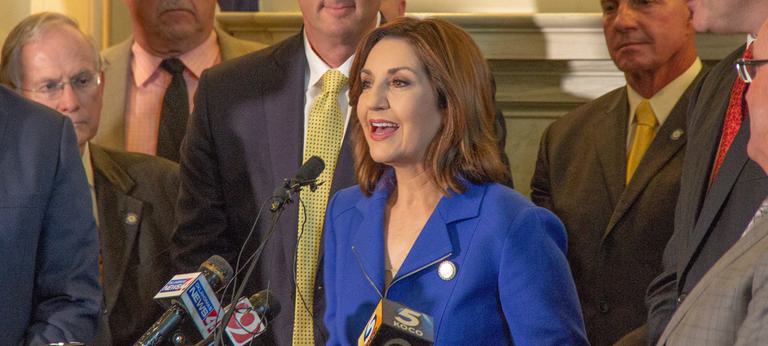
Education
Ray Carter | October 11, 2022
Hofmeister keeps COVID records secret
Ray Carter
In July 2020, State Superintendent of Public Instruction Joy Hofmeister unveiled a school COVID plan so restrictive it would have mandated closure of all schools across an 1,834-square-mile county when as few as four active COVID cases were identified.
The State Board of Education declined Hofmeister’s request to implement that plan as a mandate, but thanks to state health records Oklahomans can still know what would have happened if her plan had been adopted as a mandate and maintained. State data shows that schools in every county in Oklahoma would have been mandated or pressured to cease in-person instruction for more than half of the 76-week period from Sept. 24, 2020, to March 1, 2022.
What Oklahomans do not know is how Hofmeister’s plan was developed and why she chose such low thresholds to impose school closures that are now linked with severe learning loss.
For nearly a year, Hofmeister’s office has not responded to an open-records request for her email communications regarding COVID. Hofmeister’s refusal to provide transparency contrasts with the actions of at least one other statewide officeholder who publicly released thousands of emails and hours of recordings related to state-government COVID response.
Instead, Hofmeister’s inaction mirrors the approach taken by former officeholders criticized by a state open-records organization.
One national expert on government transparency said delayed responses to open-records requests are often a red flag.
“People in government, when they don’t want to talk about what they’ve been doing, generally speaking there is a reason why they don’t want to talk with you about it,” said Mark Tapscott, an award-winning journalist who was admitted to the National Freedom of Information Act Hall of Fame in 2006 and continues to cover Congress for The Epoch Times. “And it’s probably not something they want to see published in the media. That’s a good rule of thumb.”
Hofmeister’s Plan
Under Hofmeister’s July 2020 proposal, when county COVID rates exceeded 14.39 cases per 100,000 population, schools in that county would have been “strongly recommended” to transition to alternative schedules or distance learning.
When rates exceeded 25 cases per 100,000 population, the plan stated that districts in that county “must transition to distance learning until community transmission declines” to less than 14.39 cases per 100,000 population.
Had Hofmeister’s plan been adopted as a mandate and left in place past its original Sept. 30, 2020, expiration—which appears likely based on the extension of similar mandates across the nation—Oklahoma State Department of Health (OSDH) archives of per-capita COVID infection rates by county from Sept. 24, 2020 to March 1, 2022 indicate schools could have been strongly encouraged to close for in-person learning throughout most of the state for the majority of that 76-week period.
OSDH data show that every county in Oklahoma spent more than half of the 76-week period in the per-capita category in which closure was strongly encouraged or mandated under Hofmeister’s plan.
Some areas would have been especially hard hit. Ottawa County exceeded the cutoff for 65 of the 76 weeks, Carter County exceeded the cutoff for 62 weeks, and Comanche County exceeded the rate for recommended school closures for 60 weeks.
“When they don’t want to talk about what they’ve been doing, generally speaking there is a reason why they don’t want to talk with you about it.” —Journalist Mark Tapscott, a member of the National Freedom of Information Act Hall of Fame
Per-capita infection rates exceeded the cutoff proposed by Hofmeister for anywhere from 41 to 65 weeks in all Oklahoma counties from Sept. 24, 2020, to March 1, 2022.
Because a rate of 14.39 daily new cases per 100,000 population translates to just 0.01439 percent of residents, some low-population counties repeatedly exceeded that threshold even when very few actual cases of COVID existed locally.
For example, the week of Sept. 13, 2021, Oklahoma State Department of Health records show that Cimarron County had a per-capita COVID rate of 26.7 per 100,000, which would have resulted in mandatory school closures under Hofmeister’s plan. But OSDH records also show Cimarron County had a seven-day case count of only four at that time.
Had Hofmeister’s plan been mandated, all schools in Cimarron County, which covers 1,834 square miles, would have been closed due to those four COVID cases.
Hofmeister’s Nonresponse Contrasts with Stitt
Hofmeister has provided little public explanation on how her plan was developed or why she chose to endorse school closure based on extremely low levels of COVID infection in a county.
On Oct. 15, 2021, the Oklahoma Council of Public Affairs filed an open-records request for electronic copies of Hofmeister’s state email that contained the terms “COVID,” “covid,” “coronavirus,” “quarantine,” “quarantining,” “vaccine,” “mandate” and “mask” that were either sent or received from March 1, 2020, to Oct. 15, 2021.
The agency acknowledged receipt of the records request via email the same day.
Almost a full year later, Hofmeister has yet to produce any records.
In response to a previous request regarding Hofmeister’s July 2020 plan, a spokesman said Hofmeister’s proposal was “developed with the Oklahoma State Department of Health.” But officials have provided no other explanation.
Hofmeister’s office has not responded to a request for comment on her failure to produce any records within the past year, nor has her office responded to a request for the current status of the open-records request.
The Oklahoma Open Records Act states, “The purpose of this act is to ensure and facilitate the public’s right of access to and review of government records so they may efficiently and intelligently exercise their inherent political power.”
Joey Senat, an associate professor of mass communication at Oklahoma State University who is a state authority on freedom-of-information laws, said there is no hard-and-fast rule governing how quickly state agencies must respond to open-record requests, but he said the law indicates that a “prompt and reasonable” response time “means only the time needed to locate and compile the records while also not interfering with the agency’s other duties.”
He said that “deliberate foot-dragging by government agencies is unacceptable because access delayed is access denied and defeats the statute’s purpose.”
Hofmeister’s handling of open-record requests related to COVID contrasts sharply with how Gov. Kevin Stitt has handled similar requests. In November 2020, The Frontier reported that Stitt’s office provided that outlet more than 30 hours of the governor’s recorded video calls from March and April 2020, as well as more than 7,000 emails, in response to an open-records request.
Hofmeister’s nearly-one-year-and-counting delay in responding to an open-records request instead mirrors the nonresponses of prior state officeholders criticized by open-records advocates.
FOI Oklahoma, which states on its website that the group dreams of “an Oklahoma where requests are processed quickly, where agendas and minutes are posted promptly, and where data is freely available for download,” gives out an annual “Black Hole Award” to recognize “an individual, agency or organization that has most thwarted the free flow of information.”
In prior years, former Gov. Mary Fallin and former Attorney General Scott Pruitt were recipients of FOI Oklahoma’s Black Hole Award.
Pruitt was given the Black Hole Award after he delayed, for two years, the release of thousands of emails sought by the Center for Media and Democracy. A judge eventually ordered the release of the email under the state’s Open Records Act.
Fallin received the Black Hole Award for two consecutive years. In 2014, FOI Oklahoma noted that Fallin’s office refused to provide certain records related to prison to the Tulsa World for 15 months.
In general, Senat said government officials “should be willing and able to explain why they are taking a long time to provide documents that belong to the public.”
“Any agency taking months, much less a year, to hand over public records certainly should have a justifiable reason,” Senat said.
In many cases, Tapscott noted that lawsuits are required to force agencies to obey public-records laws, which some officeholders bank on because the cost of litigation exceeds what members of the public can afford.
“The attitude of a lot of bureaucrats and a lot of politicians is, ‘So sue me,’” Tapscott said. “Because they know that they have virtually unlimited funds because they have tax dollars to fund their legal expenses.”
Rules for Thee, Not for Me?
While Hofmeister has yet to release copies of her own emails related to COVID response, in other settings she has openly admitted emails are subject to open-records requests and public scrutiny.
Earlier this year, Tulsa Public Schools had its accreditation status downgraded for violating a state law that bans schools from teaching that “an individual, by virtue of his or her race or sex, is inherently racist, sexist, or oppressive, whether consciously or unconsciously,” including through staff training.
The sanction was imposed after an employee at Tulsa schools filed a complaint that prompted an investigation by the Oklahoma State Department of Education (OSDE), which concluded that Tulsa schools had violated the law.
The identity of the complainant became public, leading to public allegations that the teacher who made the report had faced retaliation from school officials.
When that allegation was voiced during a meeting of the State Board of Education in July, Hofmeister dismissed those concerns, pointing to open-records law.
“Complainants or individuals that do email,” Hofmeister declared, “are subject to open records.”

Ray Carter
Director, Center for Independent Journalism
Ray Carter is the director of OCPA’s Center for Independent Journalism. He has two decades of experience in journalism and communications. He previously served as senior Capitol reporter for The Journal Record, media director for the Oklahoma House of Representatives, and chief editorial writer at The Oklahoman. As a reporter for The Journal Record, Carter received 12 Carl Rogan Awards in four years—including awards for investigative reporting, general news reporting, feature writing, spot news reporting, business reporting, and sports reporting. While at The Oklahoman, he was the recipient of several awards, including first place in the editorial writing category of the Associated Press/Oklahoma News Executives Carl Rogan Memorial News Excellence Competition for an editorial on the history of racism in the Oklahoma legislature.